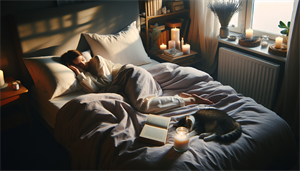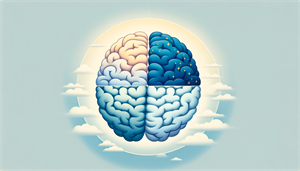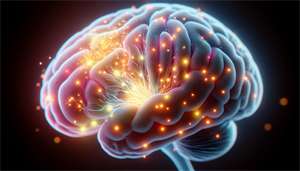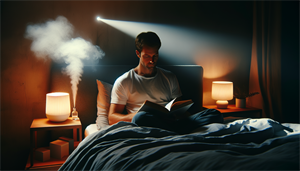Ever wondered why some people can sleep through a hurricane, while others wake up to the slightest creak of a floorboard? The secret lies in the fascinating world of sleep types, particularly in the light sleeper vs heavy sleeper spectrum.
As complex and individual as we are, our sleep patterns echo that intricacy. Understanding your sleep type, whether you’re a light sleeper, awakened by the softest whisper, or a heavy sleeper, undisturbed by the morning’s hustle and bustle, can unlock the door to better sleep health.
Key Takeaways
-
Light sleepers wake easily due to noises, light, or movement and may have a harder time reaching deep sleep, while heavy sleepers can snooze through disturbances and often feel more refreshed in the morning.
-
Sleep cycles are made up of REM and NREM stages, which both light and heavy sleepers experience differently. Light sleepers might spend more time in lighter stages, and heavy sleepers more time in deep NREM (Stage 3) sleep.
-
Creating a good sleep environment with ideal temperatures, less light, and reduced noise can improve sleep for both types. Plus, sticking to a regular sleep schedule and bedtime routine can further enhance sleep quality.
Understanding Light Sleepers and Heavy Sleepers

Sleep isn’t a one-size-fits-all process, but rather, it’s a dynamic series of stages and rhythms. At the heart of these rhythms lie two main sleep types - light sleepers and heavy sleepers.
A light sleeper, as the name suggests, is someone who is easily disrupted by external stimuli such as:
-
sounds
-
smells
-
light
-
movement
This makes it challenging for them to achieve the deep, restorative sleep necessary for optimal health.
Conversely, heavy sleepers, with a higher arousal threshold, can sleep through potential disturbances and are likely to spend more time in deeper sleep stages. Factors such as:
-
genetic predisposition
-
the presence of sleep disorders
-
the quality of the sleep environment
-
stress levels
can all tip the scales in favor of being a light or heavy sleeper. These factors can significantly influence a person’s ability to reach and maintain deep sleep stages, affecting their overall sleep health.
Characteristics of a Light Sleeper
Light sleepers tend to have a heightened awareness of their surroundings. They tend to spend more time in light sleep stages, with their muscles relaxing less compared to the deeper sleep stages. This could make them sensitive to environmental factors such as light, sounds, or smells, potentially disrupting their sleep.
Light sleepers are not just defined by their quick-to-wake nature but also by certain personality traits. They can often be more irritable and are more likely to experience heightened emotional responses and anxiety. Being aware of the characteristics and challenges of light sleepers can assist in developing strategies for improved sleep quality and overall health.
The Deep Sleeper's Profile
Unlike light sleepers, heavy sleepers can sleep through almost anything. They are the ones who hit the snooze button multiple times or might not even hear the alarm at all! The super deep, restorative kind of sleep, known as deep sleep, is their playground.
Deep sleep plays a crucial role in our well-being. It’s the stage where the magic of restoration and repair happens. Our bodies and minds recuperate from the day’s wear and tear, providing us with renewed energy and vitality. Heavy sleepers usually spend more time in this rejuvenating stage, also known as N3 sleep, allowing them to wake up feeling more refreshed and restored.
Decoding Sleep Stages: Where Do You Fall?

Similar to a symphony, sleep has various stages that form a cycle. These stages are primarily divided into Rapid Eye Movement (REM) and Non-Rapid Eye Movement (NREM) sleep, each with unique characteristics and functions. In one night, we typically go through four to five cycles of these sleep stages, providing our bodies with the rest and rejuvenation they need.
Understanding these stages and how we transition through them can reveal much about our sleep type. Light sleepers, for instance, may spend more time in the early stages of NREM sleep, while heavy sleepers may spend more time in the deeper stages, particularly the deep or N3 sleep stage.
The Journey Through NREM Sleep
NREM sleep is a journey through three stages, each progressively deeper and more restorative than the last.
-
Stage 1: A light transitional sleep, a bridge between wakefulness and sleep that usually lasts only a few minutes.
-
Stage 2: A bit deeper than Stage 1.
-
Stage 3: Also known as deep or slow-wave sleep, where the body gets all rested and recharged.
The progression through these stages differs between light and heavy sleepers. Light sleepers may spend more time in the early NREM sleep stages, making it harder for them to achieve deep, restorative sleep. On the other hand, heavy sleepers tend to hit the deep, restful stages more often, allowing them to sleep through disruptions and wake up feeling refreshed.
Diving into REM Sleep
After the calm of NREM sleep, we enter the turbulence of REM sleep. This stage is known for rapid eye movements and increased brain activity, much like being almost awake. But don’t let that fool you. REM sleep plays a crucial role in regulating your mood and emotional state and is essential for memory and learning processes.
For light sleepers, the journey through REM sleep can sometimes be a rocky one. They are more prone to dream deprivation, which occurs when they don’t get enough REM sleep. This can lead to mood fluctuations, increased anxiety, and even depression. In severe cases, it can lead to hallucinations.
Understanding and recognizing these sleep stages can help identify sleep issues and lead to better sleep management strategies.
The Science Behind Sleep Spindles

Sleep spindles, rapid and rhythmic bursts of brain activity, significantly impact whether we are light or heavy sleepers. These spindles are thought to help keep our sleep uninterrupted, acting as a shield against potential disturbances.
Interestingly, heavy sleepers tend to have more sleep spindles than light sleepers, which might help them sleep through disruptions. These sleep spindles act as bodyguards for our brains, reducing the likelihood of disturbances while our brains are busy processing memories and learning new information.
How Your Sleep Cycle Reflects Your Sleeper Type
Our sleep cycle, fluctuating sleep stages throughout the night, can reveal our sleep type. For example, light sleepers, due to their lower arousal threshold, may spend more time in lighter sleep stages, making it harder for them to achieve deep, restorative sleep.
In contrast, heavy sleepers, with their higher arousal threshold, can sail through those potential disturbances. They are more likely to spend time in the restorative deep sleep stage, known as NREM 3. This ability to achieve and maintain deep sleep allows them to wake up feeling more refreshed and restored.
The Impact of Sleep Disorders on Sleeper Type
Sleep disorders, including any specific sleep disorder, can disrupt our sleep cycle, making staying asleep difficult and affecting sleep quality. These disorders can exacerbate light sleeping tendencies, making it harder to achieve deep, restorative sleep.
They can also impact our ability to achieve and maintain a regular sleep schedule.
Recognizing Undiagnosed Sleep Disorders
The journey to better sleep health begins with the recognition of any underlying sleep disorders that might be impacting our sleep quality. Common sleep disorders such as insomnia, restless legs syndrome, and sleep apnea can greatly affect our sleep health.
If you’re consistently struggling with sleep, feeling excessively tired during the day, or experiencing unusual movements while sleeping, it might be time to seek professional help. Early recognition and treatment of these disorders can significantly improve your sleep quality and overall health.
Creating an Ideal Sleep Environment for All Sleeper Types

Creating a conducive sleep environment is key to achieving better sleep for both light and heavy sleepers. Factors such as room temperature, light, and noise can all impact our sleep quality.
Here are some tips for creating a sleep-friendly environment:
-
Set the room temperature between 60 and 67 degrees Fahrenheit.
-
Use blackout curtains or an eye mask to block out light.
-
Keep the room quiet by using earplugs or a white noise machine.
By implementing these strategies, you can improve your sleep quality and wake up feeling refreshed.
For light sleepers, reducing noise levels in the bedroom can be beneficial. This can be achieved using earplugs or by introducing white noise into the environment. Both light and heavy sleepers can benefit from choosing the right mattress and pillow that offer the right support and comfort for their sleep type.
Strategies for Improving Sleep Quality

Enhancing sleep quality requires a comprehensive approach, focusing not just on sleep duration but also its quality.
Incorporating strategies such as maintaining a regular sleep schedule, engaging in a relaxing bedtime routine, and finding ways to prevent falling asleep too quickly can significantly improve our sleep quality and help us achieve a good night’s sleep.
The Role of a Regular Sleep Schedule
A regular sleep schedule is akin to setting a rhythm for our body. It helps our body sync with its internal clock, known as the circadian rhythm, improving the timing and quality of our sleep.
Maintaining a consistent sleep schedule can offer a plethora of health benefits, including:
-
Improved heart health
-
Regulated blood sugar
-
Improved mental function
-
Stress relief
-
Improved digestion
-
Regulated mood
-
Reduced anxiety
-
Lower risk of chronic diseases
Designing a Restful Bedtime Routine
A calming bedtime routine serves as a signal, telling our brain that it’s time to unwind and prepare for sleep. This routine can include activities such as reading, meditation, or a warm bath, which can help our muscles relax and reduce stress levels, ultimately leading to better sleep.
Incorporating relaxation exercises or mindful activities into our bedtime routine can help manage stress and anxiety, improving the quality of our sleep. A consistent and restful bedtime routine is one of the most effective strategies for achieving better sleep.
Sleep Aids and Technology: Tools for Better Rest
Sleep aids and technology can be instrumental in our pursuit of improved sleep. For light sleepers, wireless sleep headphones, prescription meds, special pillows, and blackout drapes can all contribute to a better night’s sleep. Meanwhile, heavy sleepers can benefit from loud alarm clocks or vibrating smart bracelets to ensure they wake up on time.
Sleep aids work by helping our brain relax and inducing sleepiness. However, it’s important to use them responsibly, as they can be addictive and exacerbate long-term sleep issues if misused. As for sleep tech, tools like sleep apps and sleep trackers can provide valuable insights into our sleep patterns. They can help identify potential sleep issues and offer personalized recommendations for improving sleep quality.
Navigating Sleep Challenges: When to Seek Help
It’s vital to recognize when professional help is needed for sleep issues. If you find yourself snoring, feeling tired during the day, struggling to fall asleep or stay asleep, it might be time to consult a healthcare provider.
Before your visit, it can be helpful to keep a sleep diary to track your sleep habits, which can provide valuable insights to your healthcare provider. Depending on your symptoms and history, they may suggest treatment or refer you to a sleep specialist for further evaluation.
Remember, sleep is a vital aspect of our overall health, and it’s essential not to overlook any persistent sleep issues.
The Physiology of Sleep: Brain Waves and Body Functions
Sleep is a multifaceted physiological process, encompassing various brain waves and body functions. During sleep, our brain goes through different stages, transitioning from alpha to theta to delta waves as we move from light to deep sleep. These changes in brain activity are crucial for various body recovery processes, including:
-
Restoring energy levels
-
Strengthening the immune system
-
Consolidating memories
-
Repairing tissues and muscles
-
Regulating hormones
-
Promoting growth and development
In addition to brain activity, our bodily functions also change during sleep. During REM sleep, changes occur in our breathing, heart rate, blood pressure, and eye movements, similar to when we are awake. On the other hand, during NREM sleep, our bodies focus on repairing muscles, organs, and producing new cells, keeping us healthy and refreshed.
Exercise and Diet: Their Influence on Sleep Types
Our lifestyle choices, especially surrounding exercise and diet, have a significant impact on our sleep. Regular exercise can help us fall asleep faster, sleep longer, and alleviate insomnia. Activities like brisk walking, swimming, biking, or jogging can significantly improve our sleep quality.
Summary
In this journey through the world of sleep, we’ve explored the unique characteristics of light and heavy sleepers, the stages of sleep, and how they reflect our sleep type. We’ve delved into the science of sleep spindles, the impact of sleep disorders, and the importance of an ideal sleep environment. Along the journey, we’ve discovered effective strategies for improving sleep quality, explored sleep aids and technology, and learned when to seek professional help. Remember, sleep is not just a necessity but a crucial pillar of our health. By understanding our sleep type and incorporating healthy sleep habits, we can unlock the door to better sleep and, consequently, better health.
Frequently Asked Questions
What are the symptoms of a light sleeper?
If you're a light sleeper, you may wake up easily due to small disturbances in your sleep environment, such as outside noise, partner shifting in bed, or hallway light turning on. These disturbances can affect your sleep quality and leave you feeling tired.
What makes someone a heavy sleeper?
Not getting enough sleep or having irregular sleep patterns can make someone a heavy sleeper. When the body doesn't get the right amount of sleep, it can lead to feeling groggy and disoriented upon waking.
Do light sleepers have more anxiety?
Yes, light sleepers can experience heightened emotional reactivity and are more likely to have anxiety. It's important to prioritize good sleep habits to manage anxiety levels.
What makes someone a light or heavy sleeper?
Whether you're a light or heavy sleeper can be influenced by genetic predisposition, the presence of sleep disorders, the quality of your sleep environment, and your stress levels. These factors can all play a role in how deeply you sleep.
How do sleep disorders affect sleeper type?
Sleep disorders can make it harder to achieve deep, restorative sleep and can disrupt our ability to maintain a regular sleep schedule. It's important to address any sleep disorders for better sleep quality.


